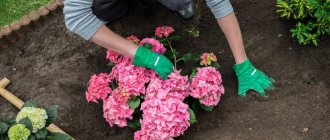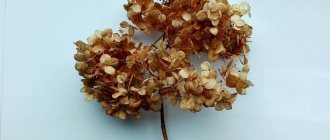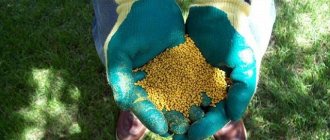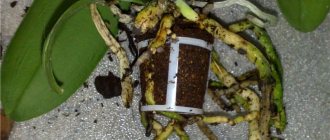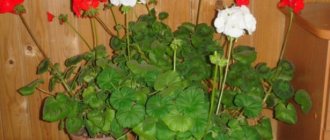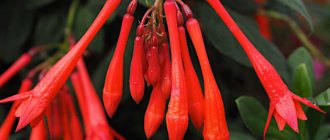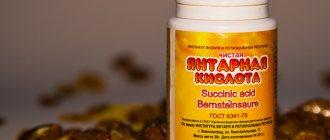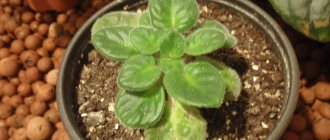How to feed hydrangea in spring
Hydrangea needs macro- and microelements, especially iron. Acidic soils are best suited for growing. Fertilizing in the spring and in the subsequent period is carried out taking into account the needs for nutrients. The shrub needs:
- nitrogen, which is responsible for the growth of green mass, succulent leaves and powerful shoots. It is important not to overdo it, otherwise the growth of greenery will be to the detriment of the flowers;
- phosphorus, provides a large number of flowers and their sizes, as well as the duration of flowering and the ability to overwinter;
- potassium ensures better flowering in the spring, and in the fall it is responsible for the frost resistance of the shrub and provides energy for the formation of buds in the future;
- microelements responsible for various processes. Magnesium is important during the period of bud setting and affects the brightness of flower color. Iron deficiency increases the risk of chlorosis, etc.
If fertilizing is carried out correctly in spring and summer, hydrangea pleases with bright green foliage, timely formation of buds and long, lush flowering. The bush gets sick less and can withstand temperature changes and other adverse weather conditions.
An important addition: if you properly feed the hydrangea during planting in the hole, you can not add anything to the soil for the next couple of years.
Mineral and organic fertilizers
There are many feeding options. Some are more expensive, others require almost no cost. Flower growers insist that all types of garden hydrangeas need care - paniculate, tree-like, large-leaved, and less common.
An approximate list of means used to fertilize hydrangeas in the spring and in the future includes:
- nitrogen fertilizer. Shown only in spring, when the snow melts. If there is excess nitrogen in the soil, the foliage will be lush and flowering will be sparse and rapid. Mineral fertilizers you can use are urea (15 g per 10 liters of water), ammonium nitrate (up to 30 g per bucket of water). Chicken manure is suitable for organic matter - the concentrate is prepared by diluting the manure with water in a ratio of 1:20, for application - 1:3. You can use mullein, nettle infusion, and also mulch the shrubs with humus, compost, and peat;
- complex mineral fertilizers for hydrangea. Nitroammophoska is suitable, in which the 3 main elements contain 16% each. Take 20–30 g of the composition per bucket of water, pour 5 liters under each bush. For fertilizer after flowering or in the fall, use diammofoska, in which the nitrogen content is reduced, and potassium and phosphorus - 26% each. The composition is diluted at the rate of 20 g per 10 liters. Considering that the listed compositions do not contain microelements, they are added separately in the form of humates;
- phosphorus-potassium compounds. Used during budding to ensure lush flowering. The most popular fertilizers are superphosphate (up to 20 g per 10 l), double superphosphate (the dose is halved), potassium sulfate (up to 20 g per 10 l). Instead of potassium sulfate, potassium salt or potassium magnesium is often used, which includes magnesium, which is useful for hydrangea;
- humates. Improves the plant's absorption of complex fertilizers.
Wood ash is not used for hydrangeas because it reduces the acidity of the soil. An exception is made when you plan to get pink hydrangeas.
Ready-made formulations
Feeding the plant will cause less trouble if you use more expensive specialized formulations containing a complex of necessary micro- and macroelements. The most popular known:
- “Fertika Kristalon” with microelements;
- "Agricola" with humates and microelements;
- Bona Forte with vitamins, microelements and succinic acid;
- "Buy fertilizers" in granules and powder with microelements.
It is important to consider that some formulations change the color of plants to blue.
Fertilizing hydrangeas in the spring with long-acting formulations is successful. Usually these are granules that are added dry around the bushes into pre-prepared holes. It is enough to add the additive once per season, and nothing else is required.
Folk remedies
One of the unusual fertilizers for hydrangeas is kefir. For a bucket of water take 2 liters of kefir, sour milk, fermented baked milk. Another option is to use a yeast solution (mix 10 liters of water, 10 g of yeast and 5 tsp of sugar) or live beer.
You can use foods that are sour but do not contain salt. To strengthen the shoots, use a slightly pinkish solution of potassium permanganate. It will prolong flowering and make flower heads larger. The effectiveness of improvised means is inferior to mineral fertilizer, but they are cheaper.
How to plant hydrangea in open ground
Before planting the plant in question, the following steps must be completed:
- site selection;
- hole preparation;
- determining the distance between plants during group planting;
- familiarization with planting technology at different times.
Choosing a landing site
When choosing a site for hydrangea, you should take into account that the bush in question loves diffused sun and partial shade. It is recommended to plant the crop on the eastern side of the territory, so that in the first half of the day the plant is well lit, and at noon it is hidden from direct sunlight.
Did you know? In the 19th century, a popular way to enrich the soil in which hydrangea bushes grew with iron was to place horseshoes or nails in a hole of soil during planting, or to bury other metal objects at the first sign of chlorosis in an adult bush.
When choosing a location, it is necessary to take into account the composition and natural characteristics of the soil. The soil should be fertile, saturated with humus and clay inclusions. When planting hydrangea, sandy soils should be avoided, and red soils are not recommended. The soil must be acidified (pH level 5.2–6.0).
A deficiency of nutrients in the plant can be seen in soils with an alkaline reaction. This can lead to yellowing and early shedding of leaves. It is desirable that the soil is well permeable and moderately moist, but in no case should you choose a wetland.
Preparing the planting hole
The next step after choosing the territory is digging a hole. An adult bush reaches quite large dimensions, so the size of the pit must have appropriate parameters. For small varieties, a hole can be dug 50x50x50 cm, and for large varieties - 80x80x80 cm.
It is also necessary to take into account the fact that the hole needs to be filled with fertilizer, so you should not worry about the large dimensions. Before applying fertilizer, the hole, where 3 buckets of water are also poured, should be left overnight, giving the soil time to absorb moisture well.
We recommend that you find out what and how to acidify the soil for hydrangea.
The next morning, it is necessary to add a nutrient mixture consisting of soil, peat, humus and sand (2: 2: 1: 1). It is also recommended to add organic matter mixed with mineral fertilizers (25 g of urea and potassium sulfate, 65 g of superphosphate). To increase the acidity of the soil, pine needles should be buried.
Distance between hydrangeas when planting
If you plant bushes in groups, then you need to take into account the distance between them. Each variety has its own parameters, so the distance will be different. For large-leaved hydrangea, the distance should be about 1.2–1.6 m, and for paniculate hydrangea - 1.5–2.5 m.
If the gardener plans to plant shrubs near other plants, then he needs to make a distance of 2.3–3 m from the crops. To plant hydrangea as a hedge, it is recommended to dig a trench 0.9–1.1 m wide. For early flowering experts advise digging planting holes with a smaller distance from each other (0.7–0.8 m). After a few years, you can thin out the plantings.
Landing dates and rules
Features of planting hydrangea may also depend on the choice of time of year. Many gardeners use the lunar calendar to calculate the required dates. Despite the fact that many experts recommend planting hydrangeas in the spring, planting can also be done in the fall and summer. To do this, you must follow certain rules.
Read about when and how to transplant hydrangea to another place.
In summer
Planting this season is acceptable for hydrangeas with a closed root system. The only difficulty is more maintenance. Summer planting is best done in the first half of June. The bush will begin to bloom in 2-3 years. If flower stalks form prematurely, it is recommended to cut them off.
The summer planting process involves the following steps:
- Dig a hole with parameters 0.5×0.5×0.5 m. The hole must be prepared a month before planting.
- Add soil composition: soil, peat, humus and sand (2:2:1:1).
- When installing a seedling in a hole, you must carefully straighten the roots without damaging them.
- Having filled the bush with soil, it should be slightly compacted.
- Water the plant with 2-3 buckets of water and mulch the ground.
It is not recommended to plant hydrangea while it is blooming, but if there are no other options, then all flower stalks should be cut off. This procedure is necessary so that the bush takes root well, and does not waste energy on blooming buds.
We recommend reading about planting and caring for herbaceous hydrangea.
in spring
This time of year is considered the best option for planting hydrangeas. Spring manipulation is more suitable for the northern part of Russia. The optimal time is April or May. Sequencing:
- Prepare a hole (0.5×0.5×0.5 m).
- Pour fertilizer from soil, peat, humus and sand into the hole (2:2:1:1)
- For a plant with an open root system, you should prepare a hill from the soil mixture; for a plant with a closed root system, such a procedure is not required.
- The seedling is placed on a hill, on which the roots must be carefully straightened. This option is used for an open root system.
- The hole is filled with soil so that the root collar is visible from the ground by 3-4 cm. This will protect the plant from rotting. Next you need to compact the earth a little.
- The bush is watered generously with 2-3 buckets of water.
in autumn
At this time, hydrangeas with a well-developed root system are usually planted. For the regions of the middle zone, the best time for planting is September, and for the south of the Russian Federation it is necessary to postpone this procedure until October.
Planting hydrangeas in the fall is carried out as follows:
- Having chosen a place and dug a hole at least 50x50x50 cm in size, you should add soil mixture into it.
- 2 buckets of water are poured into the hole.
- Before removing the seedling from the pot, it should be watered and then placed in a hole. For a plant with an open root system, it is necessary to form a hill of soil mixture in the hole and install a bush on top.
- The hole must be filled with soil without deepening the root collar.
- The plant should be watered abundantly.
- The last stage is laying a layer (5 cm) of peat and pine litter mulch.
Rules for applying fertilizing
Decorative flowers require no less attention than other crops on the site. Hydrangeas do not produce a harvest, but they are ways to transform the area during their flowering period. When feeding hydrangeas, experienced gardeners are guided by the following rules:
- The first time after winter, fertilizer is applied when the snow has completely melted and the temperature has stably established above zero. When the soil warms up to +4...+6 degrees, the roots of the flower are ready to absorb from the environment the elements they need for development.
- Dry fertilizer for hydrangea is scattered on the ground, and then loosened to a depth of 5 cm, followed by watering the soil.
- The use of liquid solutions requires preliminary moistening of the soil. The day before applying the preparations, the bush is well watered so that the root system does not get burned, but intensively absorbs the useful components of the fertilizing.
- For leaf spraying of bushes, the dosage is reduced by half compared to the norms for watering. Spraying is scheduled for the evening or performed on a cloudy day so that the leaves do not get sunburn.
- An overdose of drugs can also cause burns to the green part and roots.
Hydrangea prefers acidic soil, so to feed the flower you cannot use fertilizers that reduce its acidity: manure, wood ash, etc.
Caring for hydrangea in autumn and preparing for winter
After flowering, caring for hydrangea in the fall consists of removing faded inflorescences and preparing for winter.
- Tree hydrangea does not need to be covered for the winter; mulching is enough - it has high winter hardiness.
- In the conditions of the Middle Zone, the Moscow region, the North-West, the Urals and Siberia, be sure to cover the hydrangea for the winter, and it is better to dig up large-leaved hydrangea, replant it in pots and bring it into the house. Since this species can be grown in areas where the temperature in winter is not lower than -23.5 °C. The exception is some modern winter-hardy varieties mentioned in the “pruning” section.
- In more southern and warmer areas, you can get by with hilling and mulching.
Preparing for winter and covering hydrangeas
Inflorescences appear on last year's shoots (large-leaved hydrangea), and the goal is to completely preserve them from frost and damping off.
Since the leaves and flowers of large-leaved hydrangea are killed by light frosts at night, preparations for winter begin in mid-to-late October (after the first frost).
- Garden paniculata and large-leaved hydrangea must be covered for the winter.
- To do this, the bush is covered with earth, and the tree trunk circle is mulched with rotted manure, pine needles or peat.
- Then the stems are bent to the soil and covered with sawdust, spruce branches or dry leaves. And a box (box) is placed on top of the bush.
- After the end of spring frosts (April), the winter shelter is dismantled and pruned.
- It is better to carefully tie a large bush and make a frame shelter over it (“hut”) 8-12 cm higher than it and pour dry leaves inside it.
Preparing hydrangea for winter
Sheltering hydrangeas for the winter
Top layer of winter cover for hydrangeas
During short-term frosts, it is convenient to cover with lutrasil, white burlap or a double layer of film.
Shelter for large-leaved hydrangea for the winter from a gardener from the Moscow region
- In the fall, before night frosts arrive, cut off all the leaves from the bush. If you leave them, the flower will begin to rot. Leave only the flower buds at the tips of the branches, with a maximum of two leaves protecting them.
- Tie all the branches on the bush, 3-4 pieces of approximately the same size, into separate bundles with elastic material (elastic band, tights, strips of fabric).
- Bend the bundles as low as possible to the soil and secure with metal brackets (electrodes, thick wire). You need to bend the hydrangea to the ground carefully so as not to damage the shoots. In some varieties they become very lignified and it is better to bend them down gradually, starting with a slight slope.
- Before the start of cold weather (mid-November), cover the hydrangea with any non-woven material (burlap, agrofibre).
- Before the onset of severe frosts, remove the cover and cover the flower with dry peat, compost or leaf soil. The base of the bush is less afraid of frost than the fragile tips of the shoots, so it is sprinkled with very little.
- Place arcs over the plant and pull the covering material again, and place a piece of film on top so that the ends remain open and there is no increased humidity inside the winter shelter.
Shelter for the winter of young hydrangea
Young seedlings are not pruned, but are simply brought into the house for the winter in pots or covered with earth and additionally covered for the winter with an 11-16 cm layer of peat, dry leaves, pine needles or sawdust.
When can you open hydrangeas after winter?
In spring, you need to remove the winter cover from the hydrangea at the appropriate time to prevent the shoots from damping off.
- In mid-March, remove the film and covering material, rake out the peat or soil and cover again with burlap.
- In early April, when the night frosts end and stable warmth sets in, remove the cover from the large-leaved hydrangea completely.
Approximate dates for the Moscow region are indicated.
Winter hardiness of hydrangea
Now large-leaved hydrangea is increasingly grown in central Russia and in the Moscow region, the Urals and Siberia. However, not all winter-hardy varieties are able to bloom in any area due to different microclimates.
The plant can withstand temperatures down to -23 °C, and the most winter-hardy are tree, paniculate and ground cover hydrangeas.
The plant's winter hardiness increases if it receives a sufficient amount of water in the fall, as well as potassium-phosphorus fertilizer.
Fertilizer application timing
The first feeding of hydrangea in the spring is designed to stimulate active plant growth, and therefore has a high nitrogen content. After 2 weeks, the flower is watered with compounds that strengthen the wood. If necessary, additionally acidify the soil. The next treatment of hydrangeas is carried out in late spring to accelerate the growth of bush shoots. Approximate feeding scheme for hydrangeas:
- from April 10 to April 18 - nitrogen-containing preparations;
- May - spraying with compounds containing manganese, which strengthens the shoots and makes them flexible;
- early June - comprehensive plant nutrition, including a set of components necessary for growth and development.
Recommendations and common mistakes
When feeding hydrangeas in the spring, it is necessary to avoid mistakes that could worsen the flowering of the shrub or negatively affect its health:
- The bulk of mineral and organic fertilizers cannot be applied until the soil thaws. The exception is urea and other nitrogenous substances - they are allowed to be scattered even on snow.
- Hydrangea cannot be fed with only one type of fertilizer. The plant equally needs nitrogen, phosphorus and potassium; if there is a lack of at least one substance, the flowering of the bush will worsen.
If mineral fertilizers were incorporated into the soil when planting the crop, then feeding it is not recommended for the first two years.
How to feed hydrangea in spring for lush flowering
Hydrangeas are fertilized in the spring to help the plant fully emerge from the winter dormancy phase. Nitrogen is responsible for growing greenery and stimulating growth. The choice of nitrogen-containing fertilizers depends on the budget and size of the site, as well as the needs of the soil. The first time the bushes are fertilized is about 2 weeks after the snow melts. If the soil is not warmed up enough until then, the procedure is postponed. At this time, the plant will be helped by urea with potassium sulfate. 40 g of each substance are dissolved in a bucket of water. For 1 planting you will need 5 liters of ready-made solution.
Organic substances can be used instead of chemicals. Liquid manure diluted with water in a ratio of 1:10 works well. Choosing such a fertilizer for hydrangeas is advisable when growing flowers on neutral and alkaline soils. If the soil is podzolic, ammonium nitrate will help acidify it to the desired level.
The plant is fed the second time when the leaves have blossomed, but there are no flowers yet. The need for fertilizing with one or another type of fertilizer is determined by the appearance of the shrub. If the hydrangea looks healthy, choose potassium-containing preparations. If you notice signs of chlorosis, it is worth repeating nitrogen fertilizing.
The choice of drug and method of application also depends on weather conditions. When the ground is abundantly wet with rain, it is enough to scatter the dry preparation under the bushes and cover it with soil. In drier conditions, a liquid preparation will be needed. If you follow the terms and rules of fertilizing, hydrangea will delight you with its lush color for a long time.
Signs of Deficiency
A specialist can determine nutritional deficiency even without laboratory soil samples by the appearance of the hydrangea. A layman can also learn about this if he pays attention to the following:
- The rate of emergence of new shoots in spring. On poor soils this will happen slowly and inactively.
- Leaf coloring . Yellowing or reddening of the leaves while the midrib remains green is a clear sign of macronutrient deficiency.
- Condition of young shoots . Drying after active growth indicates the need to add mineral complexes.
- Shape and uniformity of color of leaf plates . Deformations or spots indicate depletion of the earth.
- Shedding of inflorescences . This picture indicates a lack of nutrients.
It is important to remember that all such signs may indicate infectious or viral diseases, so before you start feeding, you should make sure the plant is healthy.
How to feed hydrangea to change color
To acidify the soil and change the color of plants, once a month or more often use solutions of a weakly acidic electrolyte (10 ml per bucket of water), apple cider vinegar (100 ml of vinegar per bucket of water), or dissolve 20–40 g of dry citric acid in 10 liters of water. There will be more benefits if you add iron sulfate or iron chelate (20 g per 10 liters of water).
The color of plants is regulated by correcting the acidity of the soil - the more acidic it is, the more blue and purple tints will be obtained. If the pH is about 6–6.2, then the flowers will be crimson or pink.
General information about fertilizing for hydrangea
Systematic fertilization of hydrangea with organic and mineral substances has a positive effect on its appearance, guarantees intensive development of the bush and abundant flowering until late autumn.
Loose, humus-rich soil with an acidity level of pH within 5.5 is considered ideal for paniculate and tree-like varieties. That is why peat, leaf turf, sand and humus are mixed in equal parts for cultivation.
Alkaline soil is most often acidified with aluminum sulfate, ammonium sulfate or potassium chloride. The need to add these components is indicated by a change in the color of the inflorescences to light pink. Every year the soil is mulched with a mixture of compost, peat, and spruce needles; this procedure has a beneficial effect on the development of young seedlings.
To prevent leaves from curling and buds falling off, hydrangea is fed with urea-based mixtures, slurry and granular nutritional compositions.
It is important to know. It is prohibited to fertilize hydrangeas with mixtures and preparations that contain lime or ash. Such substances reduce the acidity of the soil, which adversely affects the appearance and lush flowering of the shrub.
Some gardeners are experimenting with fertilizers to change the color of the inflorescences.
- If you water pink large-leaved varieties with a weak solution of potassium alum or ammonia alum (4-5 g, diluted in 1 liter of water), the caps acquire a bluish color. The effect is consolidated by introducing pine needles and reddish peat into the soil.
- A solution of potassium permanganate, purchased compositions “Agricola-7” and “Flower” help to enhance the pale pink color.
- You can achieve white caps by mixing peat, river sand and loamy peat.
Useful tips
Only if fertilizing is carried out correctly and accurately will the hydrangea be lush and bloom brightly. Basic recommendations:
- Before adding additives to the soil, you should step back 20 cm from the trunk of the bush, make a shallow groove, water or pour the composition, and then cover with compost, acidic peat or humus;
- the ground is well moistened beforehand, with the exception of the period immediately after rain;
- fertilizing is carried out in the evenings or early in the morning, while sun activity is low;
- In the spring, root feeding is more often used; in the summer, foliar feeding is used.
Foliar treatment cannot replace root fertilizer. The timing and dosage are selected taking into account the manufacturer’s recommendations, weather conditions and soil composition.
Problems when planting hydrangeas and ways to solve them
1. Alkaline soil. The solutions are described above.
2. A clumsy, ugly seedling, possibly broken during transportation. Hydrangea is a very flexible crop that is easy to form during growth. If there is at least one whole branch, then over time, with the help of pruning, you will get a bush of any shape.
3. No room for hydrangeas. Nowadays miniature varieties have been developed that can be planted even in a flower garden with perennials and summer gardens. This is, for example, the ultra-compact variety of hydrangea paniculata Polestar.
Large-leaved hydrangea seedlings
Hydrangea propagation
The plant can be propagated using cuttings, seeds, grafting, or dividing the bush. The simplest and most popular among gardeners are propagation by cuttings and dividing the bush, which we will consider.
- Propagation using cuttings . The optimal time for rooting cuttings is the middle of the summer season. To harvest them, you need to use not very large annual side shoots. In order for them to take root, you need to use a light substrate of peat and coarse sand. During planting, 2 cm of sand should be poured on top of the substrate. To increase the moisture holding capacity of the soil, you can add sphagnum moss. It is recommended to plant at an angle, leaving a distance of 5 cm between neighboring plants; the optimal temperature for maintenance is from 16 to 20°C. Basically, it takes a month for the shoots to take root.
- Reproduction by dividing the bush . For this method, the time of year does not matter. The bush of the plant can be dug up for division both in spring and in autumn. It is important to leave 2-3 buds on each young plant during the division process.

